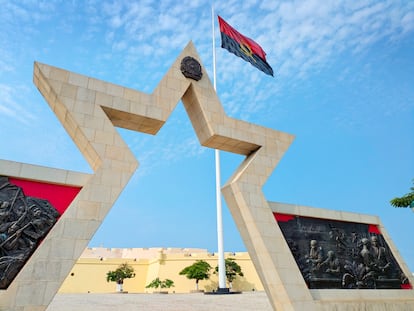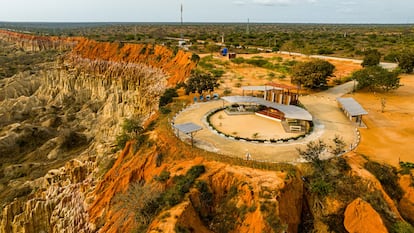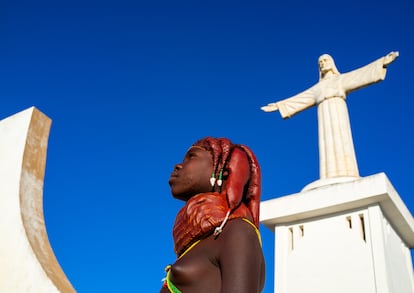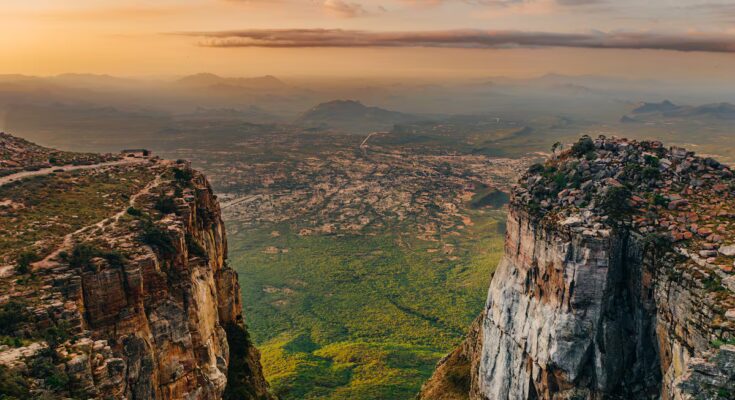If Africa told its story through the underground, it would be about the enlightenment of humanity, the incubation of resources that shaped its borders, or bribe resources for foreign businesses. In the case of Angola, this layer would show the wealth of oil, diamonds or gold. But reaching the top, the dark opulence of this country would be transformed into a diaphanous landscape, with wide horizons and luminous lands. Along the surface you could see miles and miles of barrier-free coastline, a rocky desert with remote paradises or jíbaro-lined mountain formations bathed in mustard. You could also ride for hours through bush fields escorted by all kinds of baobabs.
During the journey through the African nation the path will be interrupted by children walking along a wire circle; at food stalls where pans are bubbling with meat or vegetable stews, blocks of white rice or it worksa puree of cornmeal and water that is served with a ladle; or with the friendly and smiling greeting of various members of ancestral tribes, of busy farmers or of girls carrying the weight of a beaded hairstyle. Naturally, in Angola, with a history marked by civil war and the armoring of its borders, the souvenirs they are scarce. It’s easier to pick up charred, rust-covered bullet casings than a refrigerator magnet. Despite this, the country is working hard to overcome this tourist obstacle: there are already some posters of its most important attractions, guides that accompany travelers along the paths and local agencies that offer information to foreigners.
And it is something recent: until October 2023 Angola had a complicated visa system, which disappeared in favor of a simple stamp in the passport upon entry by land or air. According to the embassy in Spain, the government hopes that the tourism industry will soon contribute 3% to the gross domestic product (GDP). So far the sector represents less than 1%. The official data, according to what was collected in October by the newspaper Expansion, There is talk of over 100,000 visitors in the first six months of 2025, 32.3% more than the previous year. And the Government talks about reaching two million a year within a few years.
Perhaps precisely that absence of tourism, that genuine hospitality and that world to explore make it more evocative: of course, this opening puts it in the spotlight of destinations on the western border of the African continent, with the permission of neighbors Namibia and Botswana. Its enormous extension, approximately two and a half times the size of the Iberian Peninsula, offers different types of experiences both in Luanda, the capital, and on the coast or in the natural wonders of the interior. Taking into account that, as they often repeat in their streets, “in Angola everything is possible with time… or money!”
Let’s start from Luanda. City of nine million inhabitants, the ocean defines its distribution: with an important port to the north and the profile of oil chimneys expelling smoke, the main street is Marginal. It winds along the coast and is home to some colonial buildings, worn out by time and reluctance, which are interspersed with museque or favelas. Above you can see the São Miguel fortress, built during the 18th century for defensive purposes. It subsequently held various roles and today houses the National Museum of Military History.

Luanda also hides some cultural corners, such as the National Museum of Anthropology; the Iron Palace, from the 19th century and attributed to Gustave Eiffel; or one of the rooms reserved for painting in the memorial of Agostinho Neto, the first president of independent Angola and considered an essential figure: throughout the country his name will not only appear in squares or avenues, but on almost every special element, accompanied by a bust or an obelisk.

Luanda is also a good place to go for a drink in the restaurants and bars of Ilha do Cabo, a strip of land connected to the city. The most exclusive venues are located here, although the party also moves to some central spaces, where entertainment prevails. kizombaa dance that has become the nation’s cultural heritage. At night, this metropolis fills the streets “with a constellation of stuttering light bulbs,” as the Portuguese António Lobo Antunes wrote. Saying goodbye to Luanda means leaving behind a city spiritually wounded by the conflict, which lasted almost 30 years (from 1975 to 2002) and which the journalist Ryszard Kapuściński masterfully portrayed in One more day alive from the Tivoli hotel, still existing but modernized with a flashy casino and without the charismatic owners of the time.
Heading south towards Cabo Ledo, it’s worth making a stop at the Slavery Museum. This building, built in Cabo do Morro, in what was a trafficker’s chapel, served as a transshipment for men and women sold as labor to ruthless owners. You can see some drawings and pieces from that period, such as the chains used to bind them or a baptismal font to impose faith, and learn chilling facts about that move. For example, between the 15th and 19th centuries, approximately two million Angolans were sent to the so-called New World, packed into so-called slave ships. If you ask these days, guides will tell you that this exploitation isn’t over: just look at domestic inmates.

A few kilometers to the south is the viewing point of the Moon. There you can see rocky undulations sculpted by the wind and water, like claws reaching out towards the sea and whose colors range from white to pink. And the Kissama natural park, the closest to the city (and the most visited), where there are still some giraffe specimens and where the easiest thing to see are the monkeys looking for food that wander around the entrance. It would be completed with a stop at the aforementioned Cabo Ledo, a surfing mecca for its waves, its beach and resort of the area.

Following this coast towards one of the southernmost points, you will cross the coastal cities of Porto Amboim, Sumbe or Benguela – with no other attraction than the exit to the sea – and Lobito, more exceptional for its history and its future: it was one of the most important ports during the Portuguese colonization and still retains that charm of the houses of the stay or peninsula, as well as an interesting anthropological museum and the ship Zaireused to transport former president José Eduardo dos Santos to the Democratic Republic of Congo to join the guerrilla group from which the Popular Movement for the Liberation of Angola (MPLA) sprouted.
One of the gems of the trip is Namibe. Here you will not only be able to eat a typical crab in front of the sea, but you will also have access to a sandy desert and an oasis made up of palm trees and eroded stones in the shape of vertebrae. There is another area where huge red blocks seem to have fallen from the sky in the middle of the plain. In the soil of this inhospitable place we can observe, bit by bit and with the appearance of a withered root, Welwitschia mirabilisan endemic plant considered immortal: it is estimated that it can live thousands of years. This peculiarity makes it a symbol of the country.

The zigzag climb inland is due to the spectacular Serra de Leba pass. This mountain range rises vertically with rocks speckled with ocher or orange and with a perspective of immensity recorded along the dozens of curves until you pass the gap. Then you arrive in Lubango, a city with a horizontal plan, with a saluting Christ the King on the north wall (with signs of war bullets in some parts of the marble body, according to some versions) and with a hidden cemetery of tombs. Boer (Afrikaners of German-Dutch origin who crossed the borders of South Africa, their country of origin, to dedicate themselves to the cultivation of the land, grabbing large estates).

From Lubango you cannot miss Tundavala, a steep crevasse at 2,200 meters above sea level on the Humpata plateau where you can walk and see the few himba who live in the country (the Government estimates them between 20,000 and 50,000). This tribe is characterized by hair coated with a brown clay that covers the shiny and oily tresses. Heading north you cross Huambo, where the most curious thing is Agostinho Neto square and a collection of historical photos of the library, or Waku Kungo, with a landscape of jet rocks and marked by rivers where you can see the youngest people bathing and large groups of women washing buckets of phosphorite clothes.

And in the end, nothing better than Kalandula. These falls are the icing on the cake. With a height of approximately 100 meters and a horseshoe width of approximately 400, they are located in the classification continental as the second most important, behind Victoria. Surrounded by vegetation, with a path that allows you to immerse yourself almost at your feet and with moments in which the force of the water reaches the body in gusts in flocks of drops, it is the perfect finishing touch in a country where the scarcity of useless entertainment does not count: what remains is the memory, the real one, not the one they sell you. And in Angola it is on the surface, not underneath, even if there are those who have only peeked into its cracks.



